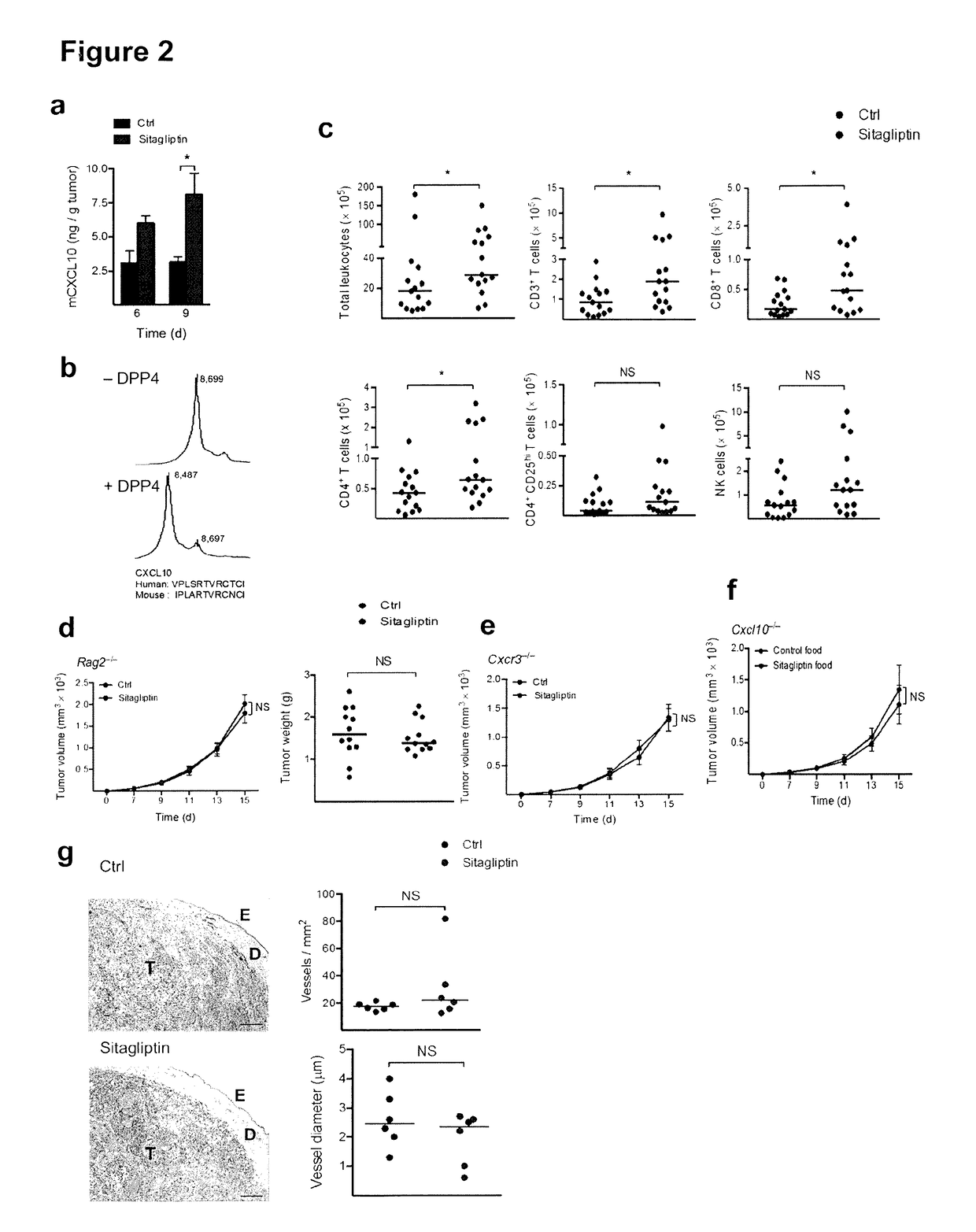Dipeptidylpeptidase 4 inhibition enhances lymphocyte trafficking, improving both naturally occurring tumor immunity and immunotherapy
a technology of dipeptidase 4 and lymphocyte trafficking, which is applied in the field of immunotherapy of cancer patients, can solve the problems of limited in vitro biochemical observations, and achieve the effect of enhancing the anti-cancer immune response in a patien
- Summary
- Abstract
- Description
- Claims
- Application Information
AI Technical Summary
Benefits of technology
Problems solved by technology
Method used
Image
Examples
example 1
[0133]WT C57BL / 6 CD45.2 Thy1.2 and BALB / c mice were obtained from Charles Rivers, France. WT C57BL / 6 CD45.1, Rag2− / −, Cxcr3− / −, Ifnar1− / − Dpp4+ / −, Dpp4− / −, Cxcl10− / −, Ccr5− / −, Pmel-1 Thy-1.1+Thy-1.1+, OT1 and FVB-Tg(CAG-luc) mice were bred in our mouse facility. Male Pmel-1 Thy-1.1+Thy-1.1+ mice were crossed with female Cxcr3− / − Thy-1.2+Thy-1.2+, mice to obtain first generation males that were Pmel-1 Cxcr3− / −Thy-1.1+Thy-1.2+. Mice used were 7-12 weeks old. For inhibition of DPP4 activity in vivo, mice were fed with chow (SAFE) formulated to contain 1.1% Sitagliptin (trade name Januvia, Merck). Sitagliptin food was administrated to mice before treatments, unless stated differently in the figure legend. Mice were maintained in a specific pathogen free facility and all experimental protocols were approved by the Cornité d'Ethique pour l'Expérimentation Animate (The ethics committee for animal experimentation) Paris.
example 2
trometry
[0134]Recombinant mDPP4, mCXCL10, mCXCL9, mCXCL11, mCCL2, mCCL3, mCCL4, mCCL5, mCXCL12 and mCCL22 were purchased from Peprotech. For surface-enhanced laser desorption / ionization-time-of-light (SELDI-TOF) mass spectrometry, chemokines were incubated in the presence or absence of 10 nM of mDPP4 for 30 min at 37° C. The digested product was applied onto an H4 protein chip, following the manufacturer's instructions and analyzed using the ProteinChip™ Systems Series 4000 (Ciphergen). Data were analyzed using CiphergenExpress Software.
example 3
Trafficking into the Peritoneal Cavity
[0135]WT and Dpp4− / − mice were intraperitoneally injected with PBS or 1□g of mCXCL10, mCXCL9 or mCCL5 (all from Peprotech). At the indicated time points, mice were sacrificed and peritoneal cells were collected in 10 ml of PBS. For thioglycollate induced peritonitis mice were intraperitoneally injected with thioglycollate 3% weight / volume, 24 hours before collection of peritoneal cells.
PUM
| Property | Measurement | Unit |
|---|---|---|
| time | aaaaa | aaaaa |
| time | aaaaa | aaaaa |
| time | aaaaa | aaaaa |
Abstract
Description
Claims
Application Information
 Login to View More
Login to View More - R&D
- Intellectual Property
- Life Sciences
- Materials
- Tech Scout
- Unparalleled Data Quality
- Higher Quality Content
- 60% Fewer Hallucinations
Browse by: Latest US Patents, China's latest patents, Technical Efficacy Thesaurus, Application Domain, Technology Topic, Popular Technical Reports.
© 2025 PatSnap. All rights reserved.Legal|Privacy policy|Modern Slavery Act Transparency Statement|Sitemap|About US| Contact US: help@patsnap.com



